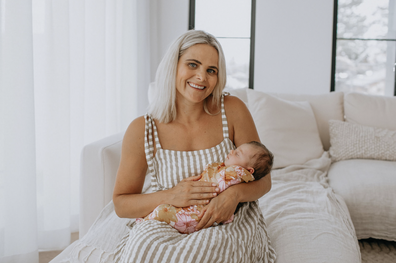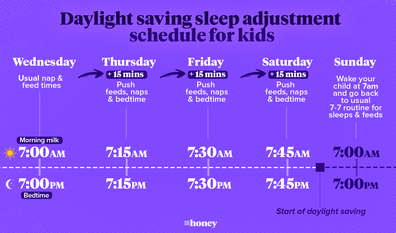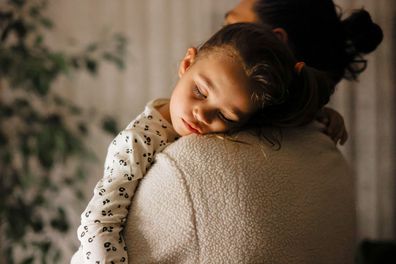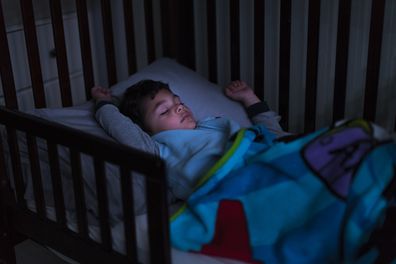How to adjust your child's sleep for daylight saving
By Nikolina Koevska Kharoufeh |
Daylight saving is something many Australian's won't even notice happen next weekend, though it's something Australian parents have been dreading for weeks now.
?For mums and dads who have found the perfect groove with their little one's night sleep, any sort of uncontrollable change seems terrifying.
Though according to ?The Sleep Teacher and CuboAi Ambassador Kristy Griffiths, the time change isn't a sure-fire disaster waiting to occur.
READ MORE: Take beautiful instant photos with these top Polaroid cameras

"It's always good to go in with a plan, but always be mindful that all babies are different, and some will be happy to adjust on the day whereas some will respond better to a gradual approach," the sleep expert shares with 9Honey Parenting.
Griffiths, who is a mum-of-three herself, knows how stressful the days before the time change can be for parents.
"It's a love hate relationship for many parents ¨C we want the extra hour of daylight, but we also want our little ones to continue to sleep well."
So how exactly do we try to ensure a seamless transition for both babies and older toddlers, who's sleep is still a sensitive challenge.
READ MORE: The comment that earned Charles this standing ovation

"When it comes to younger babies (those under 12 months), I generally find it works best to use a gradual approach . For toddlers or older, you may find it easier to adjust the 2-3 days post daylight saving," Griffiths suggests.
Her four-day plan has been calculated to allow parents to prepare their child's body clock in advance as opposed to waiting until the day - when things can go pear-shaped.
It involves starting with a small 15 minute adjustment to their nap, meals and sleep schedule, ?a simple change that will go a long way in ensuring the clock adjustment is barely felt.
READ MORE: Euphoria star's cause of death revealed

"These micro adjustments will help to make the transition as seamless as possible for everyone," she shares.
The idea is that by the time Sunday rolls around, the small 15 minute adjustments each day would have equated to the full hour, which the clocks have moved forward.
They will hopefully wake up at the exact time they usually do ¨C or as close to as possible.
Her schedule is based on a 7:00pm bedtime and 7:00am wake, though can of course be adjusted to your child's usual schedule.
For a daily dose of 9Honey, subscribe to our newsletter here.
?"You want to slowly help transition your baby towards the new daylight saving time by helping to reset your little one's circadian rhythm (body clock)."
Alongside this simple routine, Griffiths also recommends implementing a few external factors that can help enhance your little ones sleep at night.
"We want to make sure their sleep environment and day activities are set to encourage the changes we are wanting."
READ MORE: Aussie singer's 'life-altering' cancer diagnosis

Use white noise
White noise will help to act as a buffer for all the external noises that go on in our homes every day.
Noise is a huge contributor to babies having the ability to settle and sleep soundly.
With lighter evenings and mornings, we start to hear the birds a little more around bedtime and around that 5/6:00am mark, which is not an ideal wake up time for most.
READ MORE: Gross truth about towel you use all the time
Block out blinds
Light is one of the three main contributors to setting our little ones circadian rhythm.
So being able to have some control over when your bub is being exposed to light will really help to ensure that we are encouraging their body clock to reflect the adjustments we are trying to make.
Sleep hormones are also produced far more readily in the dark, so they will help to get that melatonin pumping.
Watch Now: Mum-of-two Sylvia Jeffreys opens up about ?sleep deprivation
Be consistent
As hard as it can be at times (especially when you're a sleep deprived parent), by sticking to your usual bedtime rules and behaviours you will ensure the transition is as seamless as possible.
For example, if your baby can usually go to sleep by himself, avoid lying down with him or letting him sleep in your bed.
A week of different bedtime routine while adjusting to daylight saving could be long enough to build a new habit, which you then need to deal with later on.
Like with all things sleep, consistency is going to be key to this adjustment.
READ MORE: Shop stylish backpacks perfect for the office

Social interaction
Social interaction is another one of the main contributors to setting our body clocks.
So, we really want to take this on board if we happen to have some early starts or protests at bedtime (which can be expected in the adjustment period).
A video monitor can help you see if your little one does happen to wake early or fights going down.
It can give you that bit of peace of mind that your little one is just having a little bit of trouble going down due to the time adjustment and they are ok, or help you identify if they genuinely need some assistance, and you need to go in and reassure or assist.




